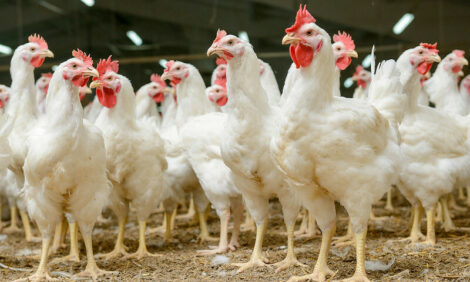



Research Progress on Green Muscle in Broilers
US - Research at Auburn University has shed some light on 'green muscle (deep pectoral myopathy; DPM) in broilers. They found the prevalence to be linked to gender, age, strain and temperature and identified an enzyme that may be useful to screen birds for DPM susceptibility.Deep pectoral myopathy (DPM) - commonly called 'green muscle' - is a breast tender necrosis that is becoming more common in broilers and often results in tender condemnation and fillet trimming, according to Roger J. Lien, Sarge F. Bilgili and Joe B. Hess of Auburn University. It is caused by wing flapping at least days before slaughter, since discolored lesions take 24 to 48 hours to develop; or several weeks earlier, since tissue damage is often permanent.
Broiler DPM will likely continue to increase, since breast yield selection and heavier processing weights are both contributing factors that are increasing, they say in the report of a study for US Poultry & Egg Association (USPoultry).
Creatine kinase (CK) is a muscle enzyme normally found in elevated amounts in plasma after muscle damage. Its levels are elevated following DPM induction in turkeys and broiler breeders. It may be useful as a non-invasive marker for detection in broilers.
In their previous USPoultry project, they developed a standardised technique to induce DPM that they called 'forced wing exercise' (FWE), which was similar to but not the same as one used in previous studies by others. They now refer to their technique as 'encouraged wing flapping' (EWF).
The project objectives were to:
- determine if temperature, time of day, or strain influence susceptibility to DPM induction by increases in light intensity and human disturbance, or EWF.
- determine the effects of age, sex, strain and bodyweight (BW) on DPM lesion development
- determine if baseline or changes in CK levels with age, or EWF, induced CK level changes in very young broilers can indicate subsequent DPM susceptibility, and
- determine the time course of CK level elevations following DPM induction.
Light intensity increases and disturbances similar to those occurring when farmers check broilers did not increase DPM incidence.
The prevalence of DPM was greater at normal temperatures that resulted in greater growth than high temperatures, greater in strains selected for breast yield.
Induction of DPM three to five days before slaughter resulted in a 10 to 20 per cent decrease in subsequent growth. Broilers gradually developed DPM susceptibility from four to seven weeks, with males developing susceptibility a week earlier than females. Bodyweight differences were not a primary factor.
Plasma CK levels in the weeks before induction of DPM were not a good predictor of susceptibility. Plasma CK levels increase much more dramatically from one to four days after EWF in birds in which DPM was induced. Therefore, plasma CK levels after EWF could be used as a non-terminal marker for DPM susceptibility in genetic selection programs.
Plasma CK level changes in response to EWF at ages too early to induce DPM did seem to be related to subsequent susceptibility, which also suggests a potential use of CK levels to screen birds for DPM susceptibility without actually inducing lesions, concluded the Auburn University scientists.








